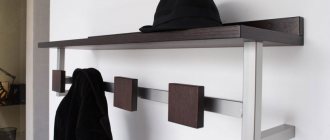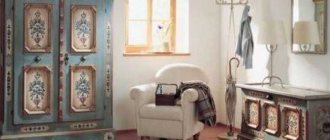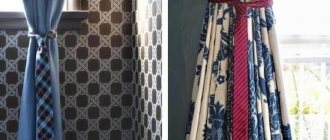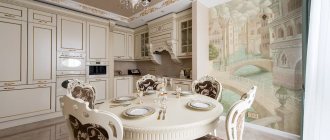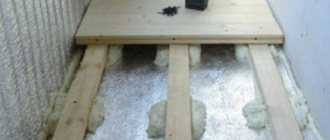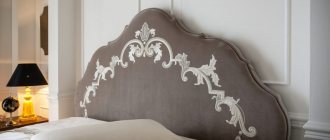False beams
Certain interior design styles - chalet, country, grunge, gothic, etc. - require beams on the ceiling. Modern mixed styles have absorbed decorative elements of different styles. Now beams are used every day by designers and decorators for interior decoration. Previously, beams were used for practical tasks - these elements supported the ceiling. Nowadays, beams perform an exclusively decorative function, so decorating the ceiling with massive oak or beech beams is not always advisable for economic reasons.
Decorative ceiling beams with lighting
An example of decorating beams on the ceiling
Now designers are actively using gypsum, polyurethane and foam beams. They are not susceptible to the load of the ceiling, which is why they are called false beams. But with the help of paint or veneer they are given the shade and texture of any natural wood.
Installation of wooden decorative beams
Decorative beams for the ceiling
Wooden beams under the ceiling are a stylish element of home decoration, emphasizing the spaciousness of the room, and in some cases carrying a functional load. Read more in this article.
Style decision
Modern
In the high-tech or minimalist style, the finishing in the form of an unusual figured stretch fabric, a suspended plasterboard structure with original lighting, or mirror and metal panels will look harmonious.
Classical
In a classic interior, the main decoration will be a wooden coffered ceiling or decor in the form of stucco molding and stained glass inserts.
Country
The cozy country design will be complemented by wood trim, in the form of panels or wooden beams. An unusual design made of untreated wood will look impressive.
Loft
The absence of finishing or its imitation best describes the original loft design. Panels with imitation concrete, stone or brick, wooden beams and metal structures made from ventilation pipes will highlight the interior design.
Textile
An interesting option for decorative ceiling finishing is fabric drapery. The use of fabric creates comfort and brings harmony to the interior.
Draping the ceiling with fabric
This finishing method is used in interior design due to a number of advantages.
- The fabric installation process does not require construction skills.
- The material hides various imperfections on the ceiling well.
- For drapery, you do not need to perform basic finishing work, because the fabric is attached to the edges of the room.
- You can lay electrical wiring and other communications on the ceiling - the fabric will hide everything.
- Drapery is an easy and pleasant way to decorate.
- If necessary, the fabric sheet can be easily removed. Convenient for repairing communications and electrical wiring in the ceiling.
- The fabric ceiling is almost impossible to damage. Minor damage to it will not be visible.
Ceiling drapery
Disadvantages include a high level of odor absorption and low resistance to humid environments.
Fabric canvas is an ideal material for creating original design effects. But they must correspond to the interior of the room in which the drapery will be made.
Fabric ceilings have many variations. It can be done, for example, in the shape of a tent or in waves. Stretching the material from the walls to the center allows you to realize individual ideas or use generally accepted methods of installing a fabric ceiling.
Draping the ceiling with fabric
Main types of fabric for drapery
To finish the ceiling covering, 6 main types of fabric are used.
- Jacquard . Used to achieve indoor comfort. Has a presentable appearance.
- Linen . Dirt is easily removed from this fabric. During installation, the material does not stretch and does not sag over time.
- Cotton. Creates an atmosphere of calm in the room.
Fabric ceiling decor
- Velvet . Luxurious fabric ceilings are created from this material.
- Chiffon . It does not stretch and does not collect dust, so it is advisable to use it in bedrooms and children's rooms.
- Silk. Gives the ceiling sophistication.
Artificial silk ceiling drapery
Varieties of ceiling surface decor
The modern approach does not oblige owners to seek help from professionals. Some options are easy to do yourself. Using one type of finish or another, it becomes possible to completely transform the room. The familiar design will become unrecognizable even to the owners. Among the many available, the following types of decor are considered the most popular:
- Stretch and fabric ceilings;
- Painting;
- Photo wallpapers and applications;
- Decoupage and painting;
- The use of polyurethane stucco;
- Drywall;
- Decorative plaster;
- Skin;
- Foam tiles;
- Parquet;
- Bamboo decorations.
Decorative plaster
The ceiling can be decorated with decorative textured plaster. It consists of special elements that create various reliefs during application to the ceiling. After it dries, it can be painted any color. It is advisable to use this type of decor when the ceiling covering is uneven, because it will not only decorate the home, but also level out the crooked ceiling.
Decorative plaster can be used in low rooms, because it does not visually reduce the height of the ceiling. Plaster is also often combined with other materials to create an imitation of natural materials (granite, marble, mother-of-pearl).
Decorative plaster ceiling
Properly selected decorative plaster on the ceiling will help give the interior a unique style and elegance.
Plaster options
Rollers for decorative ceiling plaster
Video - Finishing the ceiling with decorative plaster
Required tools and materials
Imitation stucco Decorative plaster Stencils Water-based paint Photo stickers Dyes Sponge Rubber spatula Liquid nails Glues Scissors Paint rollers Spray gun Brush Show all
It’s enough to learn how to decorate the ceiling with your own hands to make your own home beautiful and truly original. Now there are many ways to fashionably and interestingly decorate any ceiling surfaces.
- 2 Imitation stucco - exquisite surface
- 3 Decorative plaster - we make a chic ceiling ourselves
- 4 Stencils - any paintings on the ceiling surface
- 5 Decor with appliqués and photo wallpapers - original and beautiful
- 6 Painted options - chic and shine
- 7 Decorating suspended ceilings - features and tips from the pros
Stucco molding
A fairly common type of repair and decorative work is finishing ceilings with stucco. In the arsenal of designer services, stucco molding has always occupied and still occupies a place of honor. This is due to the many advantages that this type of decorative ceiling decoration has.
Stucco on the ceiling
Among them are:
- the possibility of restoration or replacement of damaged elements of a stucco composition;
- hiding defects in the ceiling and joints of the ceiling covering using fragments of moldings;
- the visual appeal of this type of decorative finishing (with the help of baguettes, rosettes, caissons, you can create various decorative compositions on the ceiling);
- the ability to highlight the advantages of a room and change its visual perception;
- durability.
Stucco molding on the ceiling made of foam plastic
Stucco elements
Stucco molding will help you quickly transform any room, making it attractive and presentable.
Stucco on the ceiling
Geometric stucco patterns, tiles imitating stone or plant motifs will not only decorate the ceiling, but will also allow you to visually adjust the proportions of the room, and focus on the chandelier or wall decor. Read more here.
Using photo wallpaper
Ceilings can also be decorated with photo wallpaper. Modern photo wallpapers come in a very wide variety. They are very bright, most importantly, high quality and easy to install. They can be used in different rooms. If you want to decorate the ceiling with an individual design, you can place an order at specialized companies. You can also arrange a fairy tale in a nursery or relaxation room, guided by the child’s wishes.
Related article: Posters and paintings for modern interiors
Artistic painting
With the help of artistic painting you can create a delightful interior in your home. Previously, to apply drawings to the ceiling, you had to call a master artist, but now there are many techniques and materials that allow you to do artistic painting on the ceiling yourself.
Ceiling painting
Stencils are special forms that make it possible to apply almost any pattern to the ceiling. You can purchase them or make them yourself. The stencils are attached to the ceiling surface using tape and then painted with the chosen paints. The main stages of working with a stencil are given below.
Cutting out a pattern for a stencil: 1 - bridges; 2 - round element of the design (made with a punch); 3 - cutting out patterns with a knife
Using stencils
Direct stencil and drawing obtained with its help
Reverse stencil and the drawing obtained with its help
Applying drawings to the ceiling using a stencil
If you don't have time to fuss with stencils, you can purchase ready-made vinyl stickers that easily stick to intact surfaces.
But there are simple techniques that can help you recreate a full-fledged artistic painting on the ceiling.
Create an imitation of clouds on the ceiling
A very interesting way to decorate the ceiling is to imitate clouds. You can bring this decor to life using paints and an ordinary sponge. It is better to decorate the ceiling in this way in small rooms, since this process is quite labor-intensive. You need a lot of paints of different origins and colors, but the final result will delight you - the room will take on an unsurpassed appearance.
Artistic imitation of clouds on the ceiling
It is advisable to start work from the center of the room. If you don’t have enough strength to create a cloudy ceiling throughout the room, you can enclose the finished part in a circle in the middle of the room, which will create the effect of a round window with a view of the sky. The second option is that white clouds have gathered only in the place where you started to draw them, and the rest of the space is clear sky. In any case, it’s worth trying to bring this incredible idea to life.
To create a “cloud” ceiling you will need:
- brush;
- several containers for diluting paints;
- wide roller;
- matte acrylic glaze;
- aquamarine and gray acrylic paints;
- emulsion white matte paint;
- matte light blue emulsion paint (you need to buy it to cover the entire ceiling).
The ceiling must be quality plastered and cleaned.
Step 1: Roll light blue paint onto a clean ceiling surface.
Step 2. Mix white paint and warm water in equal proportions. Apply the mixture to a sponge. Use a sponge (although you can also use a brush) to outline the clouds using gentle, loose movements. At the edges of the clouds, add a little white paint to make them (the clouds) visually appear denser.
Applying white paint to a light blue surface
Step 3. Using a sponge, add aquamarine paint in different places using gentle, light strokes. This is necessary for the whiteness to show through in different places.
Step 4 Sponge some more white paint onto the clouds to create a thicker, richer look to the clouds. Apply different paints in several layers. This way you can achieve depth in the image.
Artistic painting of the ceiling
The clouds are taking shape
Step 5. Using a sponge with white paint, use light movements to work on the side where the sun should shine on the clouds. Gray - where there is no sun.
Processing the “sunny” side of clouds
Step 6. Add a few more layers of paint, but make sure they are thin and do not paint over the previous images.
Step 7. Once again highlight the edges of the clouds with white tones and carefully cover everything with acrylic glaze.
Imitation of clouds on the ceiling is ready
Another option is to paint the ceiling with luminous colors.
Using this method, you can create a nice ceiling decor using paints. This is an ideal way to create an exclusive interior in your home.
Technology for making cotton wool clouds on the ceiling
Do-it-yourself clouds can be hung from the ceiling using threads or ropes
DIY cotton clouds
Ceiling decoupage with paper
Decoupage is a specific technique for decorating various surfaces. This method is often used to decorate ceilings and involves applying various patterns made from newspapers, magazines, calendars, and photographs to the surface. When choosing this finishing option, the owner of the room has a wide field for experimentation.
The main advantage of this technique is exclusivity. In most cases, decoupage can be completely re-done, especially if it was done independently, because all finishing elements are chosen by the person taking into account personal preferences. The disadvantage is the painstaking finishing process.
Ceiling decoupage
Ceiling decoration can be complete or partial. For long-term use, the finished decor is coated with several layers of acrylic varnish.
Do-it-yourself ceiling decoupage with paper
How to decorate with applications from individual pictures or their composition? First you need to prepare all the necessary tools and materials.
These include:
- acrylic lacquer;
- PVA glue;
- nail scissors;
- Printer;
- books;
- clean cloth;
- synthetic brushes;
- colored paper;
- newspapers;
- putty knife;
- brush for removing old paint;
- putty;
- primer;
- dye;
- pencil.
Table. Stages of self-decoupage of the ceiling.
| Steps, illustrations | Actions |
| Step 1 | Find a clearly defined image online or in print. It is necessary that the drawing matches the style of the interior. Designers recommend using images of natural motifs or abstractions for decoupage. |
| Step 2 | If necessary, change the image size and contrast. Create the overall composition of the decorative appliqué in advance. Print out all the selected pictures that will make up the composition. |
| Step 3 | Using nail scissors, cut out all the necessary pictures. |
| Step 4 | If the composition includes finishing the ceiling with printed drawings, then you will glue them to the ceiling. You can use another material - colored paper or fabric. If you chose colored paper or newspaper pages, then place the image cut out from the printout onto the selected material and cut out the elements of the ceiling applique along the contour. |
| Step 5 | Prepare the ceiling for application. To do this, remove the old finish using a spatula and brush. The surface must be completely free of old coating. |
| Step 6 | Level the surface of the ceiling using putty, if necessary. |
| Step 7 | Prime the ceiling and then paint it in the chosen color and wait for the paint to dry completely. |
| Step 8 | Now you have a smooth painted ceiling and prepared materials for applying the application. Before you start decorating, mark the design so that the finished composition is even and you don’t have to re-glue crookedly attached elements. |
| Step 9 | Apply PVA glue to the prepared drawings with a brush. Press the design against the ceiling and wipe the image with a clean cloth to remove all the air from the space between the design and the ceiling. |
| Step 10 | Apply acrylic varnish in 2 layers over the image. |
Matt acrylic varnish
In this same way, you can completely cover the ceiling with black and white pages from newspapers, magazines, and calendars.
Moldings
Molding is a decorative element of ceiling decoration that enriches the interior design. Moldings appeared in Ancient Rome, but are still actively used by designers. Baguettes are easy to install and remove.
Plinth decorated with wood
Materials for the production of skirting boards.
- Aluminum . Lightweight and durable material. Attaches only to smooth walls using liquid nails or screws.
- Tree . Expensive and heavy, but presentable material. Suitable for decorating rooms that include wooden furniture.
- Polyurethane . The most common material for the production of ceiling cornices. Among the advantages are an abundance of colors, a variety of shapes and an affordable price.
- Styrofoam . The advantage is low weight. Foam baguettes are easily attached to all types of surfaces using liquid nails. Foam skirting boards are ideal for interior finishing work in an apartment. The main disadvantage is the insufficient strength of the material.
Choosing a ceiling plinth
You need to choose a baguette taking into account individual preferences and the height of the room. If the room is high, then it is advisable to use wide baseboards, if it is low, narrow baguettes. If the main selection criterion is cost savings, then it is better to choose polyurethane or polystyrene foam. If you want to create an environmentally friendly interior, you need to choose a wooden or aluminum baseboard.
Self-installation of foam baguette
Let's try to figure out how to glue foam molding ourselves. A plinth made from this material will cost 3-4 times less than a polyurethane baguette. In addition, installing foam molding is much easier than other types of baseboards.
To perform this procedure you need to stock up on:
- liquid nails;
- liquid nail gun;
- spatula;
- finishing putty;
- miter saw;
- miter box;
- painting knife;
Step 1. Use a miter saw to straighten the ends of the baguette, because in most cases they are uneven. This may result in their incomplete contact during installation.
Aligning the ends of the baguette
Trim the corner joints at 45 degrees using the same miter saw.
Corner joints should be cut at an angle of 45 degrees
Another option is cutting corners using a miter box.
Step 2. Make markings to avoid the plinth falling below or above the required level if the ceiling is suspended. Cut a small piece of baguette and attach it to the wall so that it does not reach the ceiling by a couple of millimeters.
You can use a small piece of plinth for marking
Step 3. Make a beating with a cord, and if this is not possible, make marks with a pencil along the entire perimeter of the room. You will look up to them.
Marking
Step 4: Use a paint knife and some sandpaper to trim the rough corner you cut with the miter saw. The latter does not always cut materials exactly at 45 degrees.
Step 5. Spread the baguette with liquid nails.
Applying liquid nails to ceiling plinths
Step 5. Glue the baseboard to the wall. After pressing down from the bottom of the cornice, glue will flow out. Remove it with a spatula.
The plinth is glued
Removing glue residue using a spatula
Step 6. The baseboard will adhere well to liquid nails, but a gap will form at the bottom. Treat it with the same liquid nails or sealant.
After the glue has hardened, the joints between the baseboards are sealed with sealant
Step 7. Before painting, go over the joints of the baguettes with finishing putty.
Step 8. Paint the baseboard in your chosen color and let dry.
Painting the ceiling plinth with a brush
Bamboo wallpaper
Wallpaper made from natural bamboo is an original design solution that has gained popularity thanks to the fashion for oriental motifs in interior design. This material has a unique color scheme and a variety of textures, which will allow you to show your imagination when decorating the ceiling.
Bamboo wallpaper
This finishing material is used to decorate not only rooms in the home, but also administrative premises. Used to decorate the ceilings of hotels, offices and cottages. This kind of ceiling decoration organically fits into modern interior design styles.
Bamboo wallpaper is a solid canvas. They are created from thin bamboo slats. Fixed on a fabric base. For the production of wallpaper, the upper cut of the plant trunk is used, which has a pronounced bamboo structure. The canvases are produced in widths from 1 to 2.5 m.
Bamboo wallpaper options
Bamboo wallpaper on the ceiling
Rules for using bamboo wallpaper
- Unfold the wallpaper in the room whose ceiling will be decorated. Allow the material to dry or gain some moisture for several days.
- The ceiling should not be covered with peeling finishing materials, which could prevent the wallpaper from attaching.
- Do not use water-based or water-soluble glue to prevent the wallpaper from coming off the ceiling. Polychloropene-based adhesives are best suited.
- When installing bamboo wallpaper, use a respirator.
Bamboo wallpaper brings harmony and comfort to a person’s life
Instructions for finishing the ceiling with bamboo wallpaper
Step 1. Thoroughly prime the ceiling. Wait a little until the surface is completely dry.
Ceiling primer
Step 2. Such wallpaper is glued only end to end. Measure and then cut a piece of wallpaper to the required size. If you need to cut the wallpaper lengthwise, use a breadboard knife. Insert it from above between the bamboo slices and carefully guide it to the edge.
Cutting out bamboo wallpaper
When cutting material across the web, you can resort to using metal scissors. For large amounts of work, use a jigsaw.
Cross-cutting bumboo wallpaper
Step 3. Apply an even layer of glue to the prepared ceiling using a spatula, and then apply it to the wallpaper with a brush. Glue consumption is approximately 350 g/sq. m. Let the glue dry for 15 minutes.
Applying glue to bamboo wallpaper
Step 4. Place the wallpaper and press it against one side of the ceiling, then use a clean rag to rub it away from the side that touches (or you can use a rubber roller). This is necessary to ensure that there are no spaces containing air between the wallpaper and the ceiling. Then tap the wallpaper with your palm to ensure better contact with the ceiling. Repeat these steps with the next pieces of bamboo wallpaper.
Pasting the ceiling with bamboo wallpaper
Video - Instructions for gluing bamboo wallpaper
So we looked at the most popular ceiling decorating techniques. If you find the above information useful, be sure to share it with your friends and acquaintances who are doing or are going to do renovations in their home.

